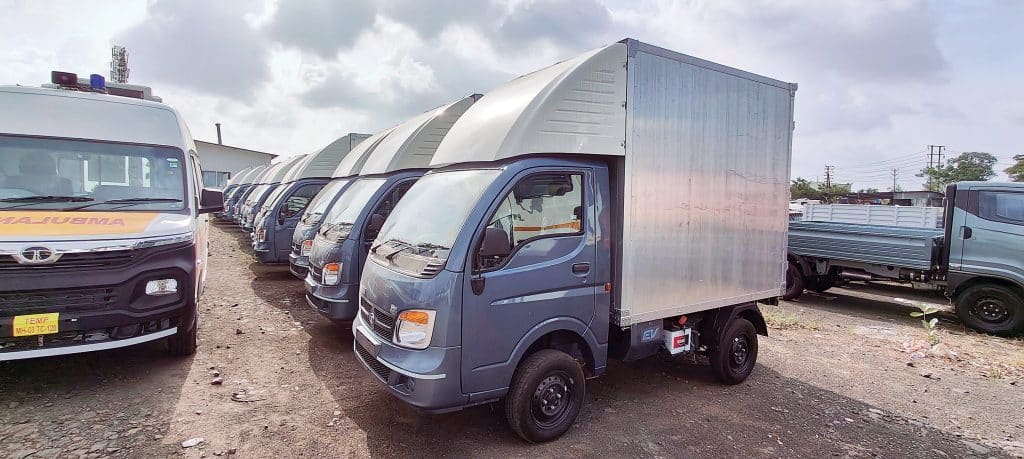Driving an electric small commercial vehicle can be a cultural shift at the beginning of your decarbonising strategy. Once you make peace with it, in this case, the Tata ACE EV, there is no looking back, writes Ashish Bhatia.
When the legacy model, the Chota Hathi Small Commercial Vehicle (SCV) turned electric in the first half of 2022, it became the face of electric four-wheeler goods carriers. If this is not a transition then what is? It warranted a run through the dense Commercial Business Districts (CBDs) where it is expected to do most rounds. Old ACE drivers were quick to spot the new avatar as they started doing the math. The math of acquisition, Total Cost of Ownership (TCO), the performance in comparison to their erstwhile Internal Combustion Engine (ICE) variant. The range anxiety extended as curiosity to learn of the battery replacement costs perceived as high. The ACE EV comes with a six year/160,000 km* battery warranty.
The metallic sheen EV badge on the nose and the charging inlet are the two major giveaways that it’s the ACE EV. The fully-built truck with the container being the other most obvious identifier were a giveaway to the erstwhile generation Tata ACE operators and competing vehicle drivers as we drove around. It was not uncommon for drivers to place the foot on the brakes and slow down as they were eager to figure out the real deal. Addressing the changing requirements of fleet operators, looking for a higher Return over Investment (RoI) over the entire life cycle, and going beyond their affinity towards discounted schemes at the beginning of this cycle, the operators till March 2024 stand to gain from the FAME II subsidy before further course of action on the flagship EV scheme is decided. The withdrawal of the scheme could see prices jump northwards of ~25 per cent
To relate to this math, it was of utmost importance to get into the driver’s head and take the hot seat! If you’ve never driven an EV you could be clueless on how to start the vehicle first up. It takes a depression of the brake pedal that is designed with a generous surface for the foot to rest on and engaging the rotary shift dial to circle to the appropriate mode before rolling on. The lack of an ignition sound requires one to be doubly conscious to avoid any mishap. Only then will you realise the vehicle is “turned on” akin to the electric consumer tech parlance like the mobile for example. You can also fall back on the central console to spot the “R-eady” state. It does take getting used to the rotary shift dial and accurately engage the desired drive mode between ‘D-rive’, ‘N-eutral’ and ‘R-everse’. The alternative arrangement of dedicated switch-based shifts over the seem more driver-friendly at this stage. Overall, the driver’s ergonomics and the cab’s utilitarian quotient have gone a notch higher.
Once you get past this familiarisation stage, you begin to appreciate the instantaneous torque at your disposal. It also requires re skilling drivers to adjust their driving in sync with the surroundings for a controlled takeoff. The motor churns out 27 kWh rated power and develops a peak rated 130 Nm torque at about 2,000 rpm. The power-to-weight ratio has been optimised to accommodate the battery weight and at the same time ensure that it doesn’t eat into the payload-carrying ability. As per Rajendra Petkar, Chief Technology Officer at the company, the ACE complies with all the regulations, it has stood the test of time and is very relevant, and therefore.” “It was natural and logical for us to go all-electric,” he stated. Leveraging customer feedback of over 15 years in which the ACE platform has evolved, the company tailored the ACE EV for E-commerce, a closed-loop operating condition to begin with, he explained. That the logistic players have sustainability high on their agenda, helped push the case. Deemed as the first credible electric SCV over competitor products by the Original Equipment Manufacturer (OEM), especially three-wheelers, it sits pretty in a league of its own, he expressed.
The ACE EV takes advantage of a Common Architecture Shared (CAS) technology which entails parts commonality and carryover from the erstwhile generations of ACE for a low TCO offering. The ACE EV also benefits from the Tata UniEVerse. It means that operators benefit from the synergies and advancements made in collaboration with Group companies and external companies. From Tata Technologies to Elxsi for the connected part of the vehicle and with powertrain players like Electra EV known to have designed and developed the 96V electric powertrain and to get the IoT quotient right. Such partnerships have enabled Tata Motors to ensure a good on road package as a transport solution provider beyond bus mobility solutions on the e-cargo mobility front.
Braking duties are carried out using a drum brake at the rear and a disc set up at the front (dual circuit hydraulic brakes). Tata Motors claims to offer a 50 per cent higher range in comparison to three-wheelers, and best-in-class power consumption of 7.6 km on a single kilowatt and a running cost of rupees one per km. The highest cargo area in terms of the cubic foot capacity of the aluminium cargo box (7.1×4.10×6.1 ft.) lends it a 0.600-tonne load-carrying ability. The 22 per cent grade ability thanks to a 160 mm ground clearance, backed by parabolic and semi-elliptical leaf springs on the front and rear respectively aid the EV to ply over the rapidly urbanising pockets that involve ascends galore over the newly built flyovers and sea bridge. The ACE EV is claimed to offer 21 connected vehicle features, the highest in the segment. It comes with the largest infotainment screen (the unit we drove did not have one) modelled on passenger vehicles. The Tire Pressure Monitoring System (TPMS) is a welcome inclusion for operators to steer clear of any unforeseen downtime. The ACE EV comes with both slow (home charging in seven hours) and fast charge (105 minutes) options to charge the lithium-ion phosphate battery pack with a 21.3 kWh, three capacity of charge in a three-phase architecture. To make it thermally stable and suited to the Indian duty cycle and tropical conditions, there is liquid cooling on board.
That a vehicle launched in 2005 is still relevant speaks volumes about the feat achieved by CV Major Tata Motors. It was a smart move to roll out the Chota hathi in its electric avatar over the more evolved Tata Intra platform. Going beyond the relevance for large fleet E-commerce players it has managed to attract, Tata Motors is finding traction with smaller fleets including owner cum drivers in the FMCG, and agro-based applications in a widening appeal.






















